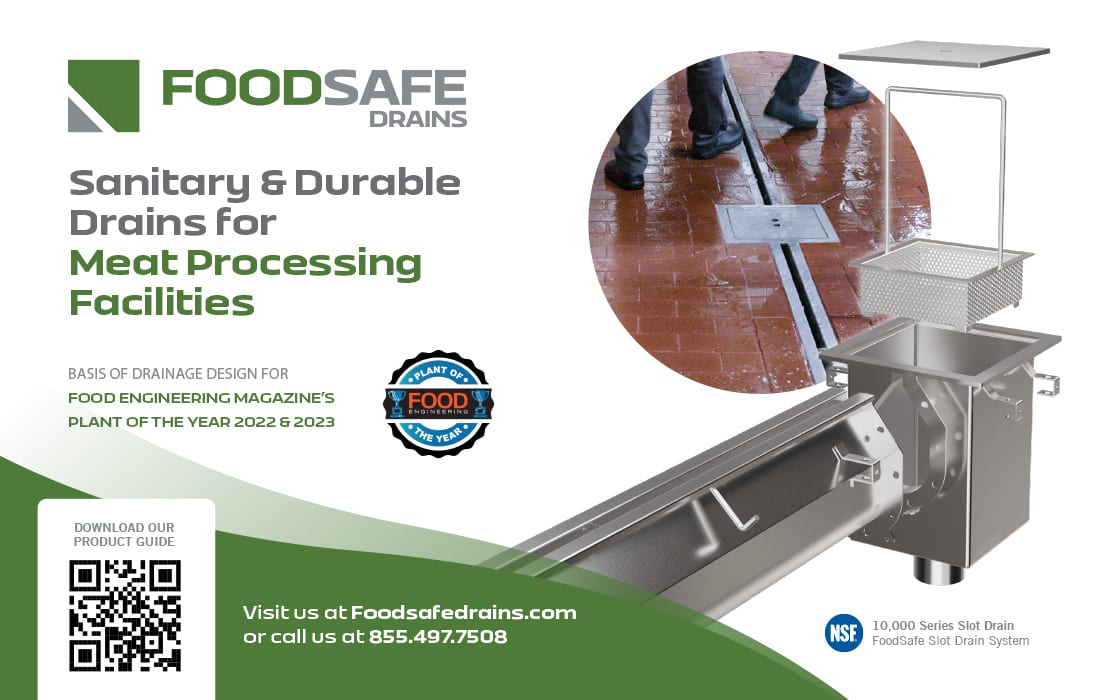2024 Trends
Signs of a recession are still around, but food and beverage manufacturers will continue to invest in their facilities to increase throughput.
Food and Beverage Manufacturing Trends for 2024
Predicting
Writing a trends piece like this one is both one of the hardest and easiest articles to create. On the one hand, you’re sifting through all kinds of data, talking to people, seeing what other people are predicting and putting it all together in a coherent piece of prognostication. On the other hand, you basically get to make stuff up and no one can really hold it against you if you get it wrong—especially if some world-altering event comes along and flips over the game board on us. Barring some existential bully doing just that, it should come as no surprise that we’re predicting food and beverage manufacturers to continue spending money to improve throughput and meet consumer demands. They’re going to do this despite continued signs of a recession lurking in the shadows.
Improving Facilities
If you’ve read anything I’ve written in the past six months or so, then this one shouldn’t come as a surprise. Based on findings from both FE’s State of Manufacturing study as well as our Top 100 Food & Beverage Manufacturers list, we’ve been saying that while profits may not have been commensurate with sales, but manufacturers plan on taking what they’ve made and putting it back into manufacturing. However, we’re not the only ones who think that.
“I look for 2024 to be a year of driving continuous improvement within existing processes as manufacturers look for innovative ways to control costs, improve upon their sustainability goals and drive profitability,” says Corey Cronin, director of global business development, food & beverage|CPG for Emerson. “The challenge will be to make the most impactful investments.”
“We are seeing that inflation is starting to flatten out, and the cost certainty is a little more predictable, which is what the clients are looking for,” says Jeff Roy, senior VP of manufacturing for McCown Gordon. “It's allowing our recon and estimating teams to be more accurate earlier, which a higher degree of cost certainty for the owners. We're able to move forward with projects more based on the enhanced knowledge that we have. A lot of the bigger concerns with cost are primarily still around the labor shortages.”
Roy’s point about the labor issues continuing to be a problem gives a huge hint regarding where food and beverage manufacturers are expected to invest: automation.
Not just anyone can provide skilled MEP work, even more so when it comes to infrastructure in a food and beverage plant. Image courtesy of Getty Images / lovro77
by Derrick Teal

Inflation is flattening out, allowing more accurate cost predictions for machinery and facility upgrades. Image Courtesy of Getty Images MJ_Prototype
During FE’s State of Manufacturing webinar in September of last year, I posited that the level of investment in automation didn’t jive the level of importance respondents to our survey were putting on it. Well, the good people at CAT Squared, a provider of smart-factory solutions, were in attendance that day and called me out. The following is from Kathy Barbeire, senior marketing manager at CAT Squared, “Our management team reviewed the survey results yesterday, and we disagree with your team’s takeaway from the data. The final bullet [on a slide in the presentation] states that there is a decrease in funding for automation, but the data says the exact opposite. Only 9% are reporting a decrease, and 31% are reporting an increase. That’s a net increase. In the field, our customers are absolutely investing in automation. We had some projects delayed until next year due to inflation, but none of our projects have been cut. If anything, our statements of work have grown.”
A report from PMMI in December 2023 backs that up. The company’s “Packaging and Automation in the Warehouses of the Future” focuses specifically on warehouses, but addresses the same staffing pain point felt across nearly every industry at the moment. But a release from the association makes a call back to a previous report in 2022, “The Future of Automation in Packaging and Processing,” that also highlights labor shortages.
“For some companies, it was a case of automating the line or stopping production,” PMMI says in a release. “CPG firms are starting to realize that a piecemeal approach to automation can be effective. Companies are increasingly demanding flexibility from their operations and the ability to alter output from production lines to meet fluctuating levels of demand.”
With the expectation that investments in automation will increase, where exactly will the focus be? “The focus should be on areas within production lines where automation can streamline repetitive tasks, reducing labor costs and improving consistency,” says Cronin. “Investing in sophisticated sensors and control systems, including IoT technology, can ensure real-time monitoring of critical parameters like machine uptime and utilities like compressed air and electrical consumption while still maintaining the quality and safety of the products produced.
“Additionally, investing in data analytics and AI can provide actionable insights, helping companies make data-driven decisions for better production planning, cost control and continuous improvement,” he adds. “2024 will, like every year, present some unique challenges, but the drive for automation and digital transformation will persist as companies seek to remain competitive, adapt to changing market demands and meet sustainability goals.”
“This growing trend indicates a heightened awareness among consumers, prompting them to inquire not only about the product itself but also about its journey from production to the shelf.” — Gil Dror, CTO, SmartSense
The areas that will be affected the most by this are mechanical and electrical, according to Roy. While the construction of a building itself is fairly universal, be it a manufacturing facility or office building, the specialized knowledge needed to ensure that those disciplines come together in a food and beverage facility properly and safely is unique and requires proper training. Roy adds that because many facilities are aging and in need of a replacement for to their infrastructure and utilities, this knowledge is even more in demand.
Regulatory Watch
Food safety has always been important, and the FDA’s Food Safety Modernization Act (FSMA) aims to improve food safety. One aspect it intends to improve is finding the source of outbreaks. As we inch ever closer to new standards being implemented, companies will continue to improve systems that allow for greater traceability.
“As organizations prepare for FSMA 2026, we will see the adoption of digital tracking systems,” says Gil Dror, CTO of SmartSense. “Similar to the processes employed by logistics giants, products will be scanned at every checkpoint, and real-time location information will be easily accessible on a dedicated dashboard. This streamlined approach is poised to enhance efficiency and transparency throughout the logistics chain.
“In the coming years, companies are anticipated to go to great lengths, such as featuring pictures of packers on labels and providing detailed information on packaging processes and the origin of products. This growing trend indicates a heightened awareness among consumers, prompting them to inquire not only about the product itself but also about its journey from production to the shelf.”
Some, such as the law firm Alston & Bird, are expecting the FDA to begin implementing additional standards. These standards range from more-stringent standards regarding the labeling of organic products and the disclosure of bioengineered food. Along that line, the firm says to expect the government to issue new rules on origin claims for meat, poultry and eggs, as well as new rules for cell-cultivated products.
Healthy Foods to Continue and Flavors to Expect
Consumer interest in healthier eating since the start of the pandemic is well documented. Additionally, pet owners wanting their fur babies to eat high-quality foods is also well documented. Don’t expect either to slow down in the coming year.
“Several factors, in my opinion, will continue to increase this movement, such as busy lifestyles, health and wellness goals for nutritional snacks, and more consumers blending snacking and meals throughout the day,” says Emerson’s Cronin. “The industry will continue to innovate new products to respond to consumers’ changing preferences.”
The PLMA released trends spotted from its most recent event. Among those of note were an expected continuation of plant-based foods, particularly with ethnic foods, and one has personally been a pleasant surprise: spicy snacks. According to a release from PLMA, “The global shift to spicy food options has found its way into the snack aisle, which is heating up with new flavor combinations featuring jalapeno, chili, habanero and other spicy peppers: Jalapeno cheddar trail mix; habanero pork rinds; spicy jalapeno sweet potato chips; habanero nacho sweet potato chips; and pineapple habanero honey roast sesame sticks.”
The organization also states that coconut-based products are also growing in popularity thanks in part to increasing awareness of the health benefits of coconuts.

McCormick has named tamarind as its flavor of the year, and has created a new Tamarind & Pasilla Chile Seasoning. Image courtesy of McCormick
McCormick also already announced its flavor of the year in its Flavor Forecast 24th Edition: tamarind. The company has made an agreement with Black Tap Craft Burgers & Beer to include the spice native from Africa in some of its menu items. McCormick has also come out with its new Tamarind & Pasilla Chile Seasoning.
"This year, we're thrilled for people to experience the taste, versatility and tang of Tamarind," says Hadar Cohen Aviram, executive chef and senior manager, culinary development, U.S. consumer at McCormick. "It is the perfect ingredient to incorporate in savory and sweet dishes which is evident through the creative, flavorful, limited-time dishes we are proudly co-developing with Black Tap."
Will all, any or none of these trends play out in the coming year? We’ll find out. FE



